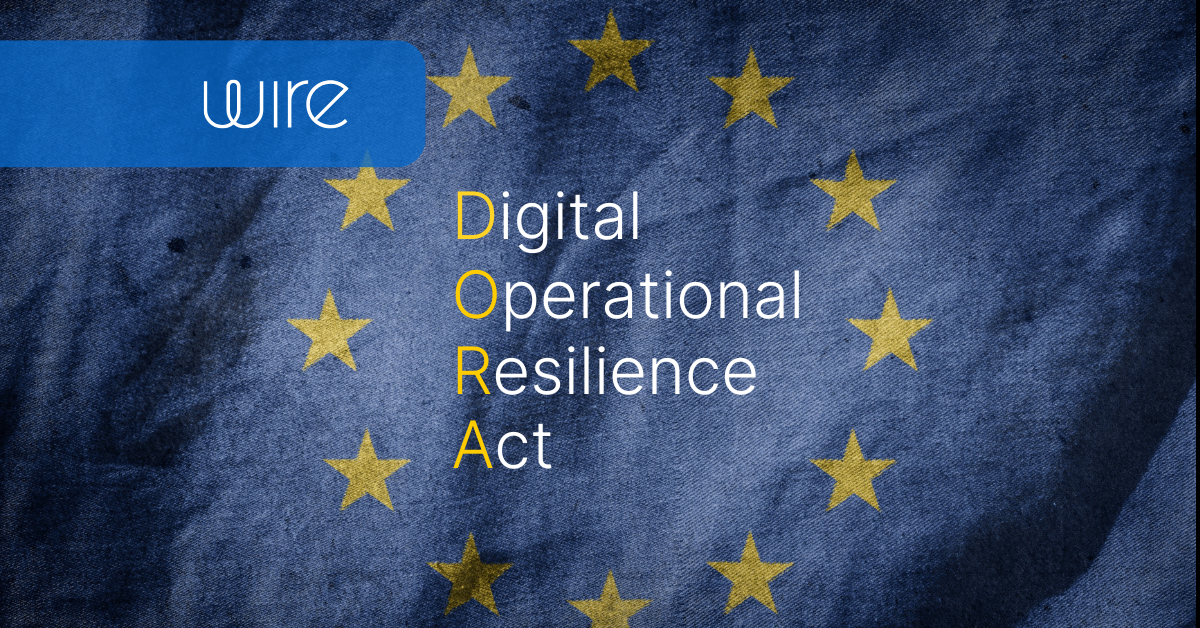The financial sector’s dependency on digital infrastructure has never been greater or riskier. From ransomware to real-time service outages, the threats are growing more frequent and more severe. That’s why the European Union introduced the Digital Operational Resilience Act (DORA), a regulation that requires financial entities to proactively manage and withstand ICT disruptions.
If your organization is part of the EU’s financial ecosystem, or supports one, it’s time to get familiar with DORA. To help companies navigate the complexity, Wire partnered with Reuschlaw to develop a new whitepaper that breaks it all down.
Download Whitepaper
What Is DORA?
The Digital Operational Resilience Act (DORA) is EU Regulation 2022/2554, and it became fully applicable as of January 17, 2025. Unlike earlier frameworks, DORA delivers a unified legal foundation for managing ICT (Information and Communication Technology) risks across the entire financial sector, including banks, insurers, crypto service providers, and their ICT partners.
Think of it as the GDPR of operational resilience. It’s technology-neutral, immediately enforceable across all EU states, and backed by the full force of law. Its goal? To ensure that financial services can continue delivering, even during cyberattacks or system failures.
But achieving DORA compliance comes with its fair share of challenges: from aligning complex ICT supply chains contractually, to building robust internal incident reporting and response frameworks. For many organizations, this means rethinking how they manage digital risk, communicate during crises, and maintain business continuity under pressure.
Why DORA Matters
DORA marks a significant shift in the EU’s cybersecurity and compliance landscape. Here’s why it matters:
- It closes critical gaps in operational risk management that were previously handled with fragmented national rules or capital buffers
- It tackles today’s threats, from sophisticated ransomware to third-party software vulnerabilities like SolarWinds
- It enforces digital sovereignty, requiring organizations to use compliant, often EU-based vendors and avoid offshore ICT providers that fall short on standards
In short: DORA is a complete rethink of how we secure finance in a hyperconnected world.
Who Needs to Pay Attention to DORA?
DORA applies to more than 20 categories of financial entities, including:
- Banks and credit institutions
- Investment firms and payment providers
- Insurance and reinsurance companies
- Crypto-asset service providers (under MiCA)
- Pension and crowdfunding platforms
- Market infrastructure providers (CCPs, trading venues)
But it doesn’t stop there.
ICT third-party providers, including cloud platforms, software vendors, hardware suppliers, and even intra-group IT teams, must also comply if they serve financial institutions. For these providers, DORA creates a dual compliance challenge, especially when combined with NIS2 obligations.
Read our NIS2 Whitepaper.
The Five Pillars of DORA Compliance (At a Glance)

To achieve digital operational resilience, DORA outlines five core compliance areas:
- ICT Risk Management
Every entity must maintain a robust ICT risk governance framework: from asset inventory to access controls and continuity planning.
- Incident Reporting
Major incidents must be identified, classified, and reported to regulators, often within tight timelines.
- Resilience Testing
Firms must regularly simulate real-world cyber threats via TLPTs (threat-led penetration tests), red teaming, and tabletop exercises.
- Third-Party Risk Management
All ICT contracts must include specific clauses on access, location, oversight, and contingency, especially with Critical Third-Party Providers (CTPPs).
- Threat Intelligence Sharing
Entities are encouraged to join threat-sharing networks to collaboratively identify and respond to emerging cyber risks.
Get Ahead of the Curve with Wire
At Wire, we help regulated organizations meet the communication demands of DORA—with secure, resilient, and compliant internal collaboration tools that keep your teams connected, even during crises.
- Encrypted fallback communication for incident response
- Support for crisis simulations
Ready to make your comms DORA-compliant?
